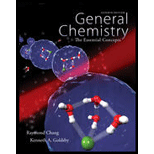
Concept explainers
Interpretation:
The method to determine whether
Concept Introduction:
An ion is a charged species formed from an atom when an atom loses or gains electron. Ions are two types – cation and anion. Cation is positively charged ion as it is formed by loss of electron. Anion is negatively charged ion and electron rich as it is formed by gaining electron.
Ionic compounds are made of such oppositely charged ions held together by electrostatic force of attraction, which is termed as ionic bond.
The energy released when gaseous state ions of unlike charges that are infinitely farther apart combine to form a stable ionic solid is called Lattice energy. Conversely, the energy required to break the electrostatic force of attraction between the ions of unlike charges in the ionic solid and revert them to gaseous state is also termed as Lattice energy of an ionic solid.
In order to conduct electricity the compound must contain mobile ions which are electrically charged.
Solid state of an ionic compound does not conduct electricity. In solid state ionic compound is neutral and the electrically charged ions are bound together by ionic bond. Hence due to the absence of charged ions ionic compounds do not conduct electricity in solid state.
Molten state of an ionic compound refers to the melted form of the compound. Upon melting the ionic compound dissociates into cations and anions ions as the ionic bonds are broken (electrostatic force). Thus molten ionic compound contains anions and cations. The ions are separated with their respective charges and are mobile that they conduct electricity.
Dissolved state of an ionic compound refers to dissolving the compound in water (solvent). The compound dissociates into individual ions when dissolved. The ions are separated with their respective charges and freely moving that they conduct electricity.
Want to see the full answer?
Check out a sample textbook solution
Chapter 9 Solutions
General Chemistry
 ChemistryChemistryISBN:9781305957404Author:Steven S. Zumdahl, Susan A. Zumdahl, Donald J. DeCostePublisher:Cengage Learning
ChemistryChemistryISBN:9781305957404Author:Steven S. Zumdahl, Susan A. Zumdahl, Donald J. DeCostePublisher:Cengage Learning ChemistryChemistryISBN:9781259911156Author:Raymond Chang Dr., Jason Overby ProfessorPublisher:McGraw-Hill Education
ChemistryChemistryISBN:9781259911156Author:Raymond Chang Dr., Jason Overby ProfessorPublisher:McGraw-Hill Education Principles of Instrumental AnalysisChemistryISBN:9781305577213Author:Douglas A. Skoog, F. James Holler, Stanley R. CrouchPublisher:Cengage Learning
Principles of Instrumental AnalysisChemistryISBN:9781305577213Author:Douglas A. Skoog, F. James Holler, Stanley R. CrouchPublisher:Cengage Learning Organic ChemistryChemistryISBN:9780078021558Author:Janice Gorzynski Smith Dr.Publisher:McGraw-Hill Education
Organic ChemistryChemistryISBN:9780078021558Author:Janice Gorzynski Smith Dr.Publisher:McGraw-Hill Education Chemistry: Principles and ReactionsChemistryISBN:9781305079373Author:William L. Masterton, Cecile N. HurleyPublisher:Cengage Learning
Chemistry: Principles and ReactionsChemistryISBN:9781305079373Author:William L. Masterton, Cecile N. HurleyPublisher:Cengage Learning Elementary Principles of Chemical Processes, Bind...ChemistryISBN:9781118431221Author:Richard M. Felder, Ronald W. Rousseau, Lisa G. BullardPublisher:WILEY
Elementary Principles of Chemical Processes, Bind...ChemistryISBN:9781118431221Author:Richard M. Felder, Ronald W. Rousseau, Lisa G. BullardPublisher:WILEY





